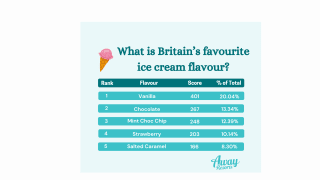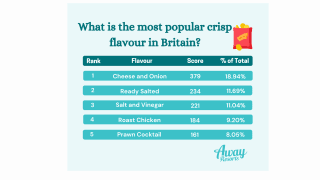Choose park
Check in
Check out
Guests
Check in/out
Guests
Search
From fish and chips on the pier to a melting ice cream under the sun, seaside snacks are a cherished part of British culture. But which treats top the list today? This nationwide survey of 2,001 UK adults takes a deep dive into Britain’s favourite coastal snacks, uncovering everything from sandwich staples to crisp preferences and classic desserts.
19 June 2025

The results reveal not only what we crave by the coast but also how our snacking habits are evolving, highlighting generational divides, regional quirks, and the cultural trends reshaping the way we enjoy food by the sea.
Key findings
48% of Brits still believe traditional seaside snacks are better than modern ones, though cost, health and dietary options are driving calls for change.
Ice cream is the nation’s ultimate seaside treat, chosen by nearly 30% of beachgoers.
Chicken mayo tops the charts, but nearly 1 in 5 Gen Z avoid sandwiches at the beach altogether.
Salt and vinegar crisps reign supreme at 38.5%, with Gen Z showing a spicy shift toward hot sauce (15.5%).
Vanilla leads as Britain’s favourite ice cream flavour.
Crisp Flavours: Cheese & Onion is Britain’s top crisp flavour (18.94%), though younger consumers increasingly prefer adventurous options like Sweet Chilli.
Over 40% had ice cream and 30% had fish and chips in the past week, while nearly a quarter haven’t touched sticks of rock in over five years.
For many beachgoers in the UK, food is a highlight of the seaside experience. Nearly half (45%) agree it’s the best part of a day at the coast, underscoring the nostalgic pull of classic treats like fish and chips, ice cream, and sticks of rock.
Still, attitudes are shifting. While 48% believe traditional seaside snacks outshine modern ones, and 45% feel they were simply better in the past, there’s also a growing appetite for change. Around 37% say they’d like to see more dietary options available (vegan, gluten-free, dairy-free) while 42% find today's snacks too expensive and a quarter feel they aren’t healthy enough to fully enjoy.
Despite these concerns, indulgence remains part of the seaside ritual: two-thirds (68%) say they treat themselves while on holiday.

When it comes to seaside indulgence, ice cream stands as the undisputed champion of British beach culture, with nearly 30% of beachgoers naming it their ultimate favourite seaside snack, offering both nostalgia and refreshment in equal measure.
And it appears sweet treats dominate, with doughnuts claiming second place at 13.85%. The appeal of fresh, warm doughnuts from seaside stalls remains strong. More substantial options also feature prominently, with hot dogs securing 9.92% of preferences and seafood at 9.82%.
At the other end of the scale, just 2.37% claim a stick of rock as their go-to treat, with similarly low figures for fudge (3.27%). Once-popular traditional seafood options like cockles (3.93%) and mussels (2.47%) also appear to be falling out of favour, suggesting a shift away from classic coastal fare among today’s beachgoers.

From humble lunchbox staple to national favourite, chicken mayo now graces more of the UK’s sandwiches than any other filling, with nearly 1 in 8 naming it their top choice. This is closely followed by egg mayo (11.09%) and cheese and pickle (10.94%), rounding out the top three. Once-dominant classics like ham and even the iconic BLT have slipped from their former glory, hinting at a shift in British tastes.
Baby Boomers are holding strong to tradition: over 22% prefer time-honoured fillings like egg mayo and cheese & pickle.
Alternatively, a surprising 19.67% of Gen Z say they avoid sandwiches entirely at the beach, nearly double the national average.

It’s official: fish and chips remain Britain's most beloved comfort food. But over half of all respondents (55.4%) cite chips as their ultimate chippy choice. The golden, hand-cut potato has maintained its crown as the nation's favourite, followed by battered cod at 30.3%, a testament to the enduring appeal of this centuries-old pairing.
And it appears Britain's regional identity extends to the fish counter. Battered cod dominates the South East and London. Meanwhile, battered haddock maintains fierce loyalty in Scotland and Yorkshire.
Classic items like scampi and pickled eggs are losing ground, particularly among younger consumers who show little interest in these traditional offerings. Perhaps most telling is the fate of mushy peas, beloved by 32% of the Silent Generation and 23% of Baby Boomers, yet barely registering among younger diners.

The real question is, what topping do you want on your chips? Salt and vinegar take the crown at 38.5%, with tomato ketchup trailing at 32.9%.
Baby Boomers and Gen X remain steadfast guardians of tradition, with 54% and 47% respectively championing salt and vinegar, the classic British combination that has graced chips for generations. Yet lurking beneath these established preferences, Gen Z's embrace of hot sauce at 15.5% represents a new generation's appetite for heat and global flavours.
The North West, Yorkshire, North East, and Northern Ireland have (perhaps unsurprisingly) claimed gravy and curry sauce as their condiments of choice. Scotland stands apart with an impressive 50.9% preference for salt and vinegar, perhaps the strongest regional loyalty to this time-honoured pairing. Meanwhile, over a quarter of those from Wales claim cheese is number one.

There’s nothing more quintessentially British than an icecream on the beach. Vanilla remains Britain's most reliable ice cream companion at 20.04%, but the choices that follow reveal shifting tastes across generations. Chocolate at 13.34% and mint choc chip at 12.39% maintain steady appeal, while strawberry's 10.14% shows traditional fruit flavours still compete with contemporary innovations like salted caramel at 8.30%.
Vanilla commands remarkable loyalty among 25-34 year olds at 31.12%, while mint chocolate chip finds its strongest advocates in the 16-24 bracket at 14.39%.
Most surprisingly, Gen Z drives the revival of Britain's most traditional treat, the iconic 99 with flake, capturing 9.09% of their preferences, nearly double the national average. Similarly, salted caramel, often dismissed as a millennial trend, actually peaks among over-55s at 10.15%, proving contemporary flavours can win over traditional palates.

Cheese & Onion holds onto its crown as the UK's favourite crisp flavour, winning the hearts of nearly one in five consumers (18.94%). Ready Salted secures a solid second place at 11.69%, with Salt and Vinegar close behind at 11.04%. Roast Chicken and Prawn Cocktail round out the top five at 9.20% and 8.05%, respectively, a clear nod to the enduring appeal of classic British flavours.
Yet while the traditional favourites continue to dominate, the data reveals a growing curiosity for more adventurous tastes. Notably, Sweet Chilli resonates strongly with younger consumers, capturing 10.44% of preferences, a sign of shifting palates and a rising appetite for bolder, more complex flavours. In contrast, older age groups show greater loyalty to time-honoured classics.
Fish and chips remain the go-to beach bite: nearly 1 in 3 people (30%) have had them in the past week alone and just 6% say they’ve never indulged. The classic combo of vinegar, salt, and sea air clearly hasn’t lost its charm.
Ice cream is even more freshly devoured over 40% have had one in the past week, proving it's still the ultimate seaside refreshment.
But some seaside staples are fading into memory. Sticks of rock and candyfloss have seen better days. Nearly a quarter haven’t had rock in over five years, and 22% say the same about candyfloss.
Seafood like cockles, mussels, and jellied eels splits the crowd. While a few hardy fans still enjoy them regularly, nearly 4 in 10 have never touched cockles, and more than half say the same for jellied eels.
So, whether it’s chips fresh from the fryer or a nostalgic nibble from decades past, our taste for seaside snacks might shift over time, but the British beach diet still knows how to deliver.

This study represents a comprehensive analysis of British food preferences based on survey data from 2,001 UK adults. The findings provide valuable insights for food industry stakeholders, cultural researchers, and anyone interested in understanding contemporary British eating patterns and their broader social implications.
Whilst you wait... just think about being in your swimmers, the sun's out and the smiles are big
Enter your details to make a payment or request a change
Don't remember your details? Check your confirmation email, or speak to our team
Are you an owner with us? Click here to login